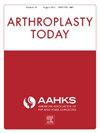Evaluation of Active Intraoperative Nerve Monitoring in Severe Developmental Dysplasia of the Hip Patients Undergoing Total Hip Arthroplasty
IF 1.5
Q3 ORTHOPEDICS
引用次数: 0
Abstract
Background
Total hip arthroplasty (THA) stands as the standard treatment in neglected developmental dysplasia of the hip (DDH), and its application in severe cases may be linked to debilitating outcomes, including nerve damage. Here, we aimed to report the results of intraoperative nerve monitoring (IONM) via an active method.
Methods
In this retrospective cohort study, we recruited patients with Crowe types III and IV DDH, who underwent THA. The study comprised 2 cohorts: one without nerve monitoring and the other with active IONM under epidural anesthesia. The primary study outcomes included the incidence of neural complications, the extent of achieved leg lengthening, and the necessity for femoral osteotomy.
Results
A total of 183 patients were included in this study as the cases underwent THA under epidural anesthesia and IONM, along with 156 historical cohorts of controls. In the group with IONM, no clinically postoperative nerve injury was detected, while in the control group, 6 (3.8%) patients experienced neural complications (P = .08). The mean achieved limb lengthening was significantly greater in the monitoring group as 4.2 cm (range = 2.4-5.6) than in the control group as 3.56 cm (range = 2.2-5.6) (P = .04). The rate of femoral osteotomy was significantly lower in the monitoring group (13.6%, 25/183) compared to the control group (27.5%, 43/156) (P < .005).
Conclusions
The utilization of active IONM in patients under epidural anesthesia during THA for severe DDH proves to be an effective approach. This method allows for real-time assessment of nerve function throughout the surgical procedure, demonstrating its potential to minimize postoperative complications.
求助全文
约1分钟内获得全文
求助全文
来源期刊

Arthroplasty Today
Medicine-Surgery
CiteScore
2.90
自引率
0.00%
发文量
258
审稿时长
40 weeks
期刊介绍:
Arthroplasty Today is a companion journal to the Journal of Arthroplasty. The journal Arthroplasty Today brings together the clinical and scientific foundations for joint replacement of the hip and knee in an open-access, online format. Arthroplasty Today solicits manuscripts of the highest quality from all areas of scientific endeavor that relate to joint replacement or the treatment of its complications, including those dealing with patient outcomes, economic and policy issues, prosthetic design, biomechanics, biomaterials, and biologic response to arthroplasty. The journal focuses on case reports. It is the purpose of Arthroplasty Today to present material to practicing orthopaedic surgeons that will keep them abreast of developments in the field, prove useful in the care of patients, and aid in understanding the scientific foundation of this subspecialty area of joint replacement. The international members of the Editorial Board provide a worldwide perspective for the journal''s area of interest. Their participation ensures that each issue of Arthroplasty Today provides the reader with timely, peer-reviewed articles of the highest quality.
 求助内容:
求助内容: 应助结果提醒方式:
应助结果提醒方式:


